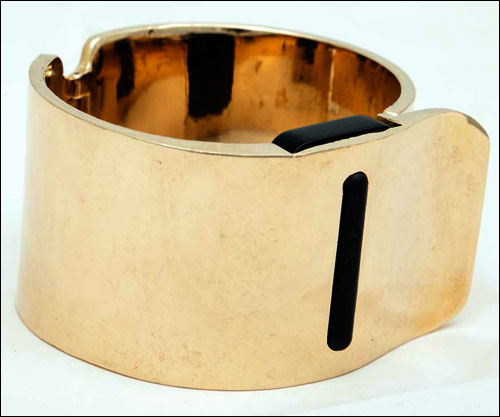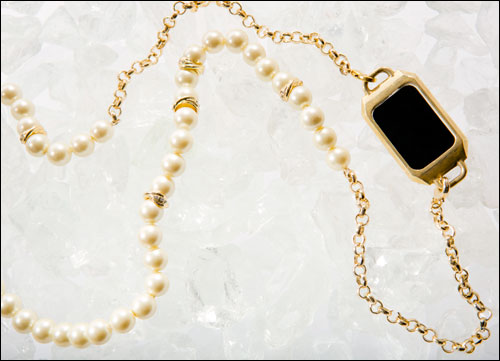Cuff is a modular “smart jewelry” system that integrates a removable sensor module into a range of different jewelry options. The idea for Cuff came to founder Deepa Sood during a dinner party she and her husband were hosting last year in their Bay Area home. “My husband and his friends were geeking out over their fitness trackers, while I marveled at the [wristbands’] James Bond quality,” says the former VP of product development for Restoration Hardware. “Then we [the women at the party] tried them on, and we were immediately trying to hide them behind other pieces of jewelry.”
Sood says Cuff grew from a very simple concept. “I wanted to make a wearable that I would wear,” she explains, and she also wanted it to support applications that had relevance to her life. To that end, she designed the Cuff system to enable her to receive important alerts. “When I go to a restaurant,” says the mother of three, “I want to know if my husband calls or my babysitter calls. That’s it.”
To launch the company, Sood reached out to California-based venture capital fund Tandem, which provided $600,000 in seed funding (she is nearly complete with a second, larger round), as well as a helping hand in finding sources with whom she could work to develop the sensor and software application. She made the initial prototypes of the jewelry components, she says—which include both bracelets and pendants worn on a necklace—”using a 3D printer, in my garage, with my kids.”
A Bluetooth Low Energy (BLE) sensor inside the Cuff module is paired with a wearer’s smartphone. The user sets rules on the Cuff smartphone app that causes the sensor to vibrate whenever people on her special list call or text (assuming the phone and Cuff are within read range of each other, such as in the wearer’s bag or pocket). Cuff also has a safety feature: If the wearer gets into a dangerous situation and requires help, a certain sequence of presses on the module (which she determines while setting up the app) generates a distress call to a pre-selected list of contacts, along with her location (based on the phone’s GPS coordinates).
The original Cuff module had a non-rechargeable battery that would last for one year of normal use. The second iteration of the module, which is slated to begin shipping early next year, contains a rechargable battery and an accelerometer that can be used to track the wearer’s activity, as well as forward this data to the Cuff app, just as any fitness tracker does (some other trackers on the market contain additional biometric sensors to monitor such factors as heart rate or blood oxygenation). In addition to jewelry, the Cuff now also comes with a silicon band to hold the module while a wearer exercises.
Sood says she was blown away by the positive response Cuff received from the outset, adding, “We got immediate traction, and the business evolved very quickly.” The phone started ringing, and that led to some very big partnerships. Cuff and a major jewelry manufacturer have inked a partnership through which the larger company will sell products designed to house the Cuff module. What’s more, Cuff has entered into discussions with a number of prominent consumer brands, including Kate Spade, L’Oréal and Montblanc, to co-develop products with the Cuff module integrated (Montblanc makes a range of men’s jewelry).
As Cuff develops these partnerships, Sood says, it is evolving from a jewelry company into a technology platform.
What sets Cuff apart from other businesses selling wearables, its founder notes, is not necessarily that it sells a product initially developed for women, but that its approach to product development started with the user and what she wants in a product, rather than beginning with the technology and then trying to find a way for consumers to incorporate it into their lives.
Integrating the sensor module into something that many women already wear each day—jewelry—is key. “There is limited real estate on the body, and it [the wearable technology] has to become habit-forming,” Sood states, in order for it to work well for consumers. The Cuff approach puts the consumer into the position of curator, in terms of deciding what to wear each day. Meanwhile, the benefits that the module provides are knit into the product’s “fabric.”
Cuff is not the only wearable-electronics company venturing into form factors aside from the basic wristband, however. In late 2012, Misfit launched its Shine tracker, which can be worn on a clip or pendant, but is not overtly sporty-looking. Signalling some competition for the women’s market, Misfit is partnering with Victoria’s Secret, which is selling the Shine tracker at its stores and online.
Sood says her background developing products for Restoration Hardware was also key to Cuff’s success. “That experience,” she explains, “taught me how to merchandize, what the supply chain is, and how to put a physical product out into the world—stuff that I think a lot of people in the IoT world don’t know how to do.”
Regardless of whether that is true, the approach is clearly working. Cuff projects $1.4 million in revenue by year’s end, through sales of the first iteration of its module (which does not support fitness apps), and through pre-sales of its second-generation Cuff, which enables users to track the number of steps they take daily. The Cuff app also allows wearers to track how many calories they eat each day (which they input manually) and how many they burn, based on their activity levels. Until now, she says, the company has consisted of Sood and “a motley crew of contractors.” But now, for good reason, she is hiring.




